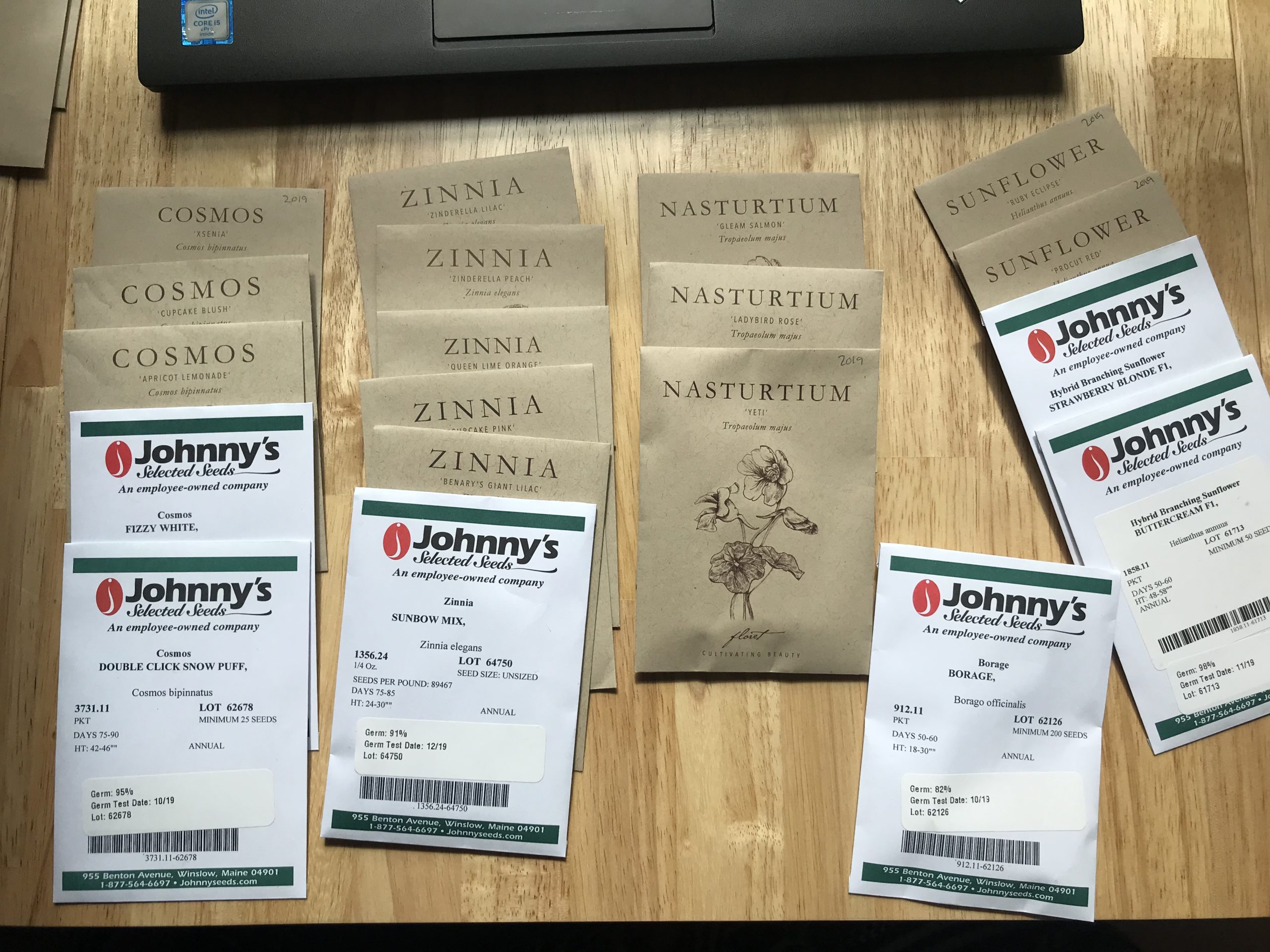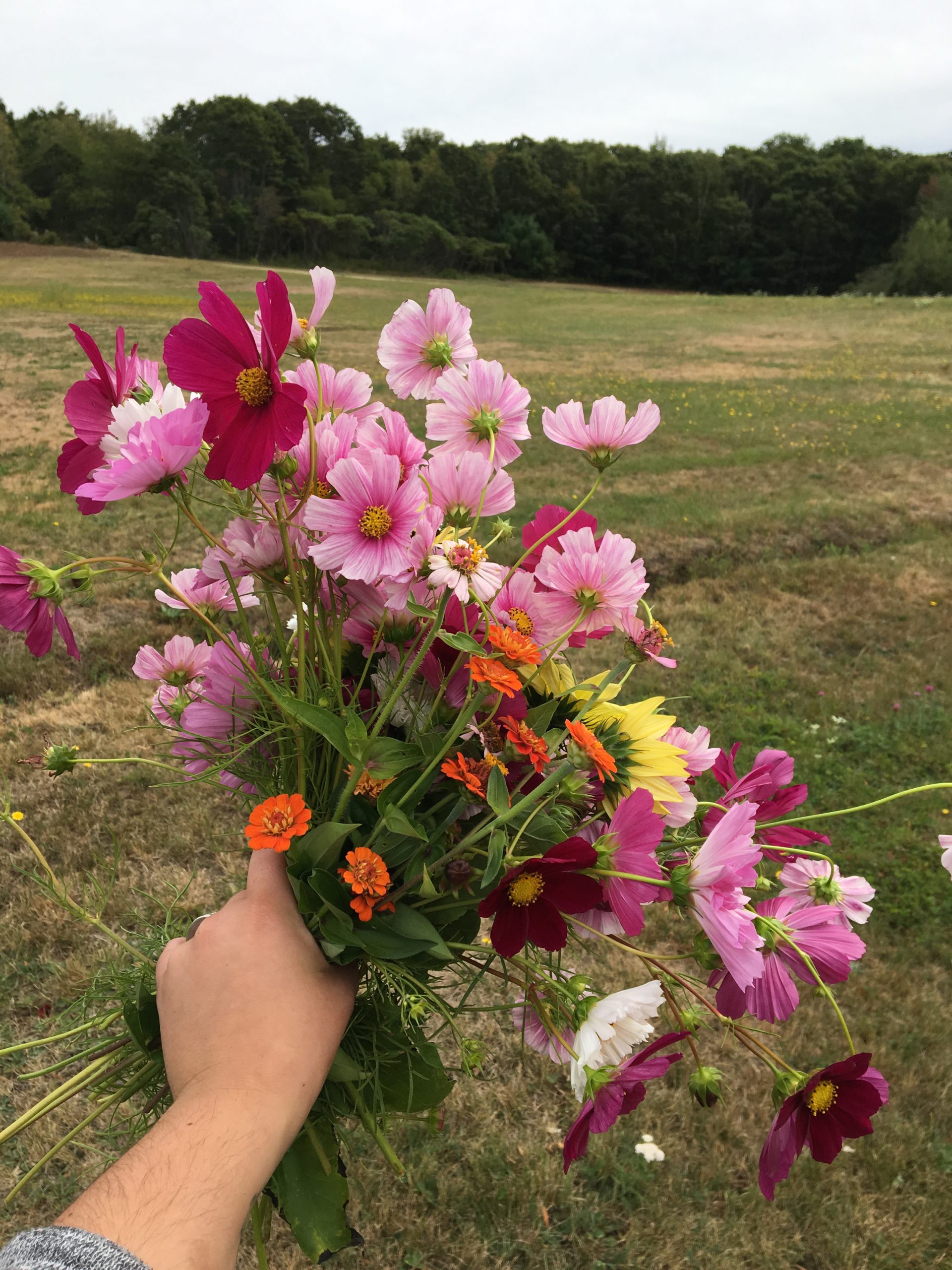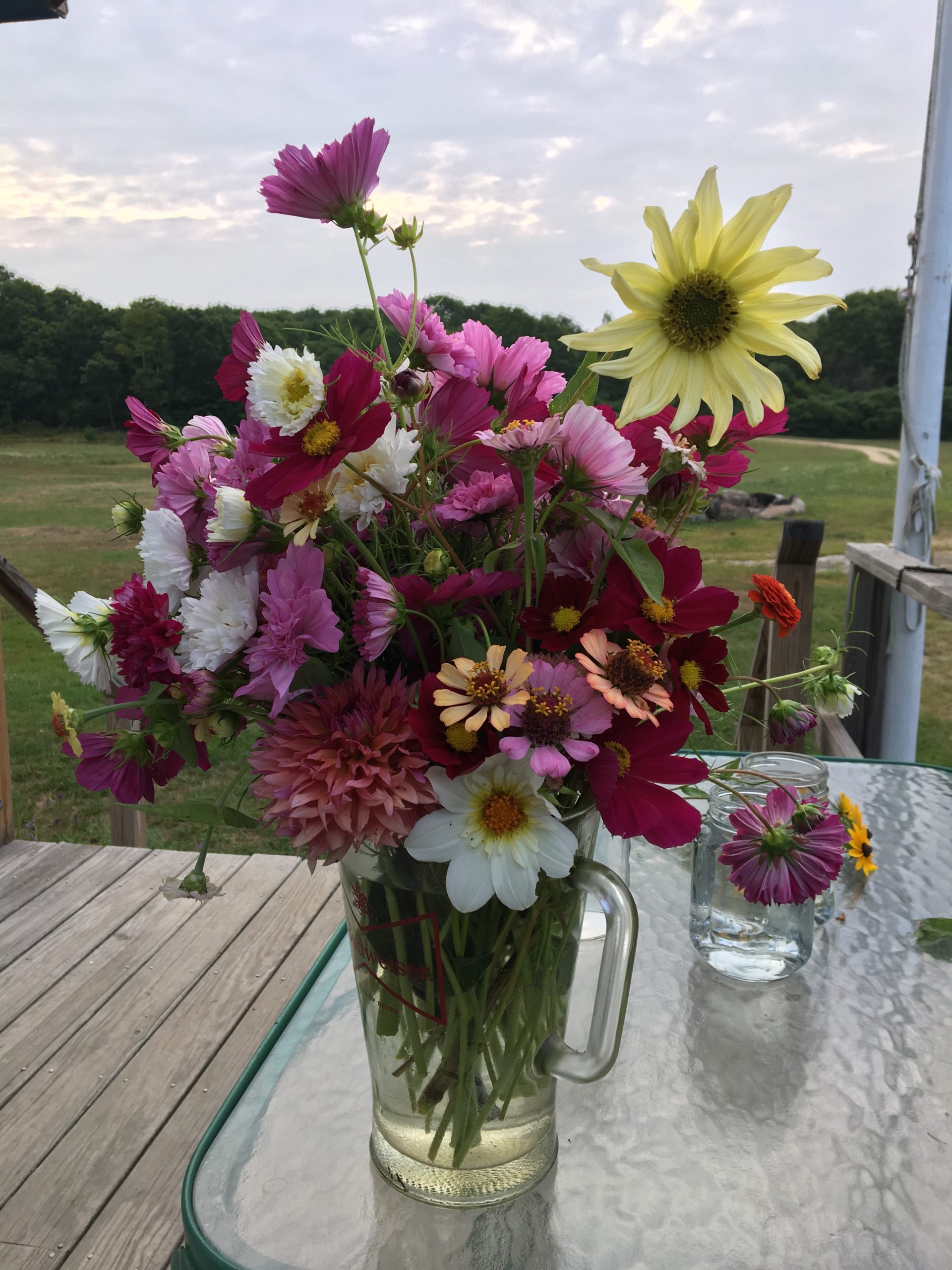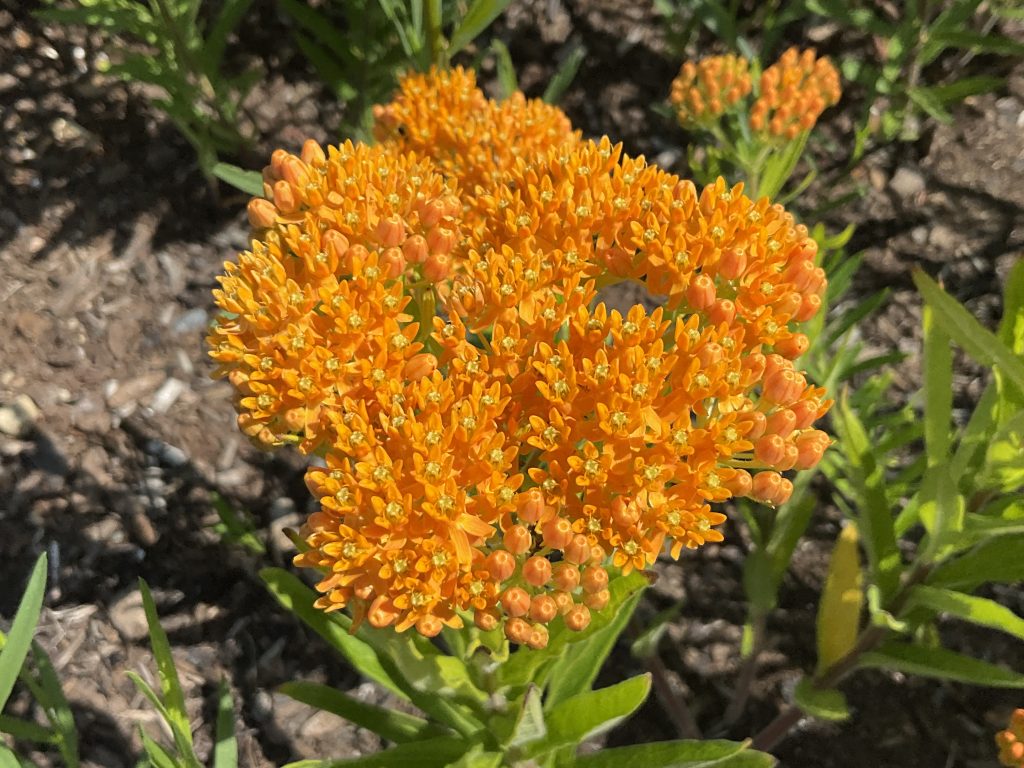When starting your own cut flower garden, choosing from amongst the enormous variety of seeds out there can be a little overwhelming. I end up wanting one of every variety of every flower known to mankind. The best advice I can give is to limit your selection to a handful of easy-to-grow flowers, and then pick a couple varieties of each, giving yourself some bouquet and arranging options for later in the season. This is even truer if you are a beginner, or have a limited amount of space. Picking one of everything is so tempting, but you are likely to become overwhelmed very quickly, giving the whole thing up as a bad job.
In my experience, the plants listed below are some of the easiest and most rewarding to grow. I have also listed some of my favorite varieties of each, but in the end, it comes down to your own personal preference of color, form, and size. I largely select varieties in (and a variety of) shades of pink, salmon, lilac, purple, carmine, and peach. That’s just personal preference, since I tend to reach for those colors when making arrangements or bouquets for loved ones. But it’s fun to experiment—maybe try to find flowers tending towards blue and grey.

Plants
Zinnia. You almost cannot have a cut flower garden without this garden workhorse. Many types are considered “cut and come again,” as the more you harvest, the more new (and even bushier) growth emerges. They are easy to start from seed and come in almost every color imaginable. They also come in many forms, from scabiosa-flowered varieties like the Zinderella series, to tiny pom-poms, cactus flowered, and big, single or double-flowered varieties. If you want a rainbow and a couple of sizes to choose from, I recommend getting both the Benary’s Giant and Sunbow mixes, which will give you a great variety of color and size.
Favorite varieties include: Zinderella Peach and Lilac, Sunbow mix, any of the Benary’s Giant (I love Wine, Purple, and Lilac), and the Queen Lime series for unique color combinations.
 Cosmos. If I could only recommend two flowers to start with, these would follow a close second after zinnias. Cosmos, another insanely prolific bloomer, are very easy to grow. In fact, if space is limited, I would plant fewer cosmos; even just a handful of these bushy plants will produce armloads of flowers. They come in beautiful shades of pink, white, red, yellow, and orange, with some cool new varieties in cross shades of apricot, rust, and peach. If you’re having trouble deciding, I recommend the Sensation or Versailles mixes, and then the Double-Click or Seashell mixes—these will provide the widest variety in color and form.
Cosmos. If I could only recommend two flowers to start with, these would follow a close second after zinnias. Cosmos, another insanely prolific bloomer, are very easy to grow. In fact, if space is limited, I would plant fewer cosmos; even just a handful of these bushy plants will produce armloads of flowers. They come in beautiful shades of pink, white, red, yellow, and orange, with some cool new varieties in cross shades of apricot, rust, and peach. If you’re having trouble deciding, I recommend the Sensation or Versailles mixes, and then the Double-Click or Seashell mixes—these will provide the widest variety in color and form.
Favorite varieties include: Cupcake Blush, Fizzy White, Double-Click mix (they’re so full and fluffy), and Xsenia, Apricot Lemonade or Rubenza for unique shades.
Sunflowers. I know what you’re thinking—that the mental image of sunflowers doesn’t really jive with my aforementioned preferred shades. Perhaps you’re also thinking that sunflowers might seem a tough arrangement sell (you know, if you’re not into Van Gogh), but hear me out. Beyond those cheery yellow giants that are such fun in the vegetable garden, there are some amazing varieties of branching sunflowers in different shades that mix well into arrangements and bouquets. I specify branching varieties (typically Helianthus annuus) since, when cut, they will still grow off-shoots of flowers versus their more familiar upright, single-stemmed cousins that, once cut, are simply finished growing and flowering. While there are some interesting shades in the single-stemmed varieties, I prefer plants that aren’t spent after one cut.
Favorite varieties include: Vanilla Ice, Strawberry Blonde, Buttercream and Ruby Eclipse. The one exception I’ll happily make as far as branching vs. single stem is ProCut Red, which, while single-stemmed, is such a beautiful deep and moody shade of red that I think it’s worth it. If you have children, Teddy Bear is a fun variety as well.
Sweet Peas. To add a little wild sweetness to arrangements, you can’t go wrong with sweet peas. They are easy to grow and come in every color and shade. The only caveat is that you will need a support structure for these beauties—the vines can grow 6+ feet throughout the summer, as long as you keep them watered and it doesn’t get too hot in your area. A sturdy trellis or netting and post system is an absolute must. The payoff, however, will be immense: sweet peas will bloom and bloom as long as you keep them from setting seed (as in, cut off spent flower stems before they go to seed), and there’s nothing so special as a handful of these sweet blooms. If you can’t narrow down your color selection, the Elegance Formula or Royal mix can be a nice alternative, providing multiple colors in a single seed packet.
Favorite varieties include: Midnight, Blue Shift, Balmoral, Porlock, Gwendoline, Charlie’s Angels, Earl Grey, Marjorie Carrier, Castlewellan, and Nimbus. This list could easily be more than two-dozen varieties long, but it all comes down to what colors you love.
Or: Nasturtiums. Don’t have the space for the support needed for sweet peas, but still want a vining flower in your arrangements? Nasturtiums, while in fewer colors than sweet peas, can be easily tucked into hanging baskets, window boxes, and porch planters, left to spill over the sides or even left as groundcover to sprawl through a garden bed. Looking like tiny lily pads, their leaves also make great greenery in arrangements. (You can also toss the flowers into salads for a peppery bite and unexpected color!)
Favorite varieties include: Forget the traditional hot colors you’re used to in nasturtiums, and instead search for creamy ivory Yeti, unusual Salmon Gleam, or unique Ladybird Rose.
Greens & Filler. To be very honest, I forage more greens than I purposefully grow. My favorite add-in is the catmint (Nepeta varieties) from my perennial garden, as the leaves are delicately spaced with a blue tint and the tiny purple flowers a lovely surprise. It also smells wonderful and grows abundantly.
Otherwise, I tend to plant borage, dill, a few differently colored basils, and sage, and will cut from these for filler and greenery. I prefer plants that do double duty in the garden, if possible, and these herbs are also wonderful in the kitchen. They add scent to arrangements, which—while I love it—is something to consider if you are giving your flowers to someone who has a sensitive nose or will be enjoying them in an enclosed space.

Resources
Johnny’s Selected Seeds. My single favorite place to order seeds from is Johnny’s Selected Seeds. Not only are they an employee-owned, local Maine company that I love to support, they are also a wonderful resource—from tons of great varieties to a wealth of helpful information and useful supplies. You can’t go wrong with this company.
Floret. I also source unique seed varieties from Floret, although they can sell out of their rarer stock fairly quickly. There are some helpful planting guides in the resources section of this site as well. Founder, Erin Benzakein, has also written a wonderful book that I highly recommend, Cut Flower Garden, if you’d like to jump in a little deeper. Floret is a great inspiration, as Erin has taken her flower farmer aesthetic into the mainstream.
Locally. Lastly, most local nurseries, garden supply companies, and greenhouses have a pretty good selection of seeds available in addition to started plants, soils, and gardening supplies. I usually look for seeds from the Botanical Interests brand, or Baker Creek Heirloom Seeds when available, as the varieties can be a little more interesting.
Final notes
I know it can be tempting to get one of everything, but there are ways to help expand your arrangements without setting yourself up for a massive cutting garden commitment. Foraging for flowers in your own perennial beds, if you’ve got them, is a great way to add more elements to arrangements, which is what I do. I lightly borrow from my veronica and salvia for flower spikes, peonies and roses for focal flowers, and monarda and yarrow as colorful filler. Borrowing in a mindful manner from your perennial gardens or landscape plantings can add some wonderful variety to the flowers you grow in a cutting garden. I also cut wildflowers on my property: lupine, Queen Anne’s lace, goldenrod, and even hairy vetch (Vicia villosa) can add an unexpected—and beautiful—touch to arrangements.
— Tory Paxson, digital marketing coordinator (& cut flower enthusiast!)

